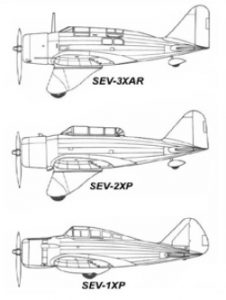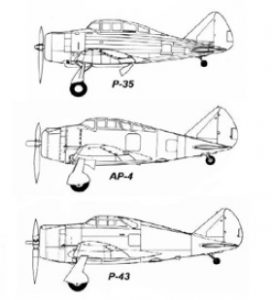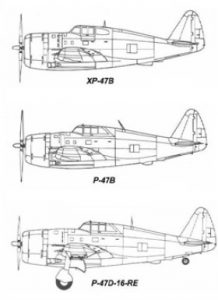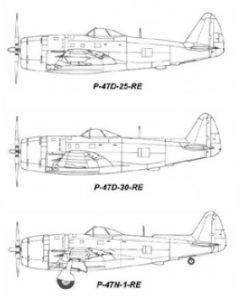by Martin Maisel (photos as credited)
By 1941 the P-43 Lancer was regarded as obsolete because it lacked adequate maneuverability, protective armor, and self-sealing fuel tanks. Furthermore, recognizing that the P-43 and its derivatives would be inferior to Luftwaffe fighters, Republic and the USAAC elected to develop a new aircraft designed around the Pratt & Whitney R-2800 Double Wasp engine. Again Alexander Kartveli led the design team.
Using a designation given to an earlier, but now abandoned, Republic lightweight fighter (the XP-47), the XP-47B would be designed to be faster, fly at greater altitudes, and be capable of longer range than other fighter aircraft in the USAAC inventory. Specification targets included a speed of 400 kts at 25,000 ft with at least six .50 caliber machine guns (eight preferred). The aircraft would also have self-sealing fuel tanks and protective armor for the pilot.
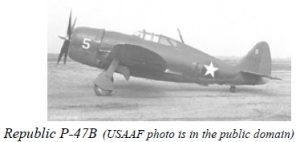 The first flight of the XP-47B occurred on May 6, 1941 and initial deliveries of the P-47B were made to the newly organized United States Army Air Force just over a year later. Named the Thunderbolt, the P-47 was affectionately known as the “Jug”.
The first flight of the XP-47B occurred on May 6, 1941 and initial deliveries of the P-47B were made to the newly organized United States Army Air Force just over a year later. Named the Thunderbolt, the P-47 was affectionately known as the “Jug”.
A number of P-47B design, production and maintenance problems were addressed with the P-47C variant, and deliveries of that model began in September 1942. Configured with the “razorback” fuselage like the P-47B, later production “C” models featured all-metal control surfaces (replacing fabric covering that could fail during high speed dives), a mass-balanced elevator and rudder to avoid flutter, and an extended fuselage (forward of the cockpit) to resolve a center of gravity problem and ease engine maintenance.
 In addition, the aircraft was fitted with a belly shackle for a bomb or for an extended-range fuel tank. By the end of 1942 most problems with the aircraft had been worked out and P-47Cs were sent to England to join the Eighth Air Force. Continuing refinements of the P-47 at Republic led to the P-47D. Later “D” models
In addition, the aircraft was fitted with a belly shackle for a bomb or for an extended-range fuel tank. By the end of 1942 most problems with the aircraft had been worked out and P-47Cs were sent to England to join the Eighth Air Force. Continuing refinements of the P-47 at Republic led to the P-47D. Later “D” models
incorporated a bubble canopy for improved visibility. Empty weight of the P-47D-30 had grown to 10,000 lb, with a maximum take off weight of 17,500 lb, making the P-47 the heaviest singleseat, single-engine fighter of World War II.
The P-47D was capable of 433 mph in level flight at 29,000 ft (550 mph in a dive), had an 1800 mile ferry range and a combat range of 800 miles.
The final variant, the P-47N with increased internal fuel capacity and external drop tanks, was designed as an escort fighter for Boeing B-29 bombers flying raids on the Japanese home islands. The last Thunderbolt, a P-47N-25, rolled off the production line in October 1945.
 A total of 15,636 Thunderbolts of all types were built – more than any other WWII U.S. fighter. Of that number about 3,500 P-47s were lost to all causes in combat.
A total of 15,636 Thunderbolts of all types were built – more than any other WWII U.S. fighter. Of that number about 3,500 P-47s were lost to all causes in combat.
During WWII P-47s flew over a half million missions, dropped over 132,000 tons of bombs and destroyed over 3,661 enemy aircraft.
The powerful, robust, well-armed P-47 Thunderbolt was considered to be one of the premier World War Two fighters by U.S. Army Air Forces commanders, along with the P-51 Mustang and the P-38 Lightning.
